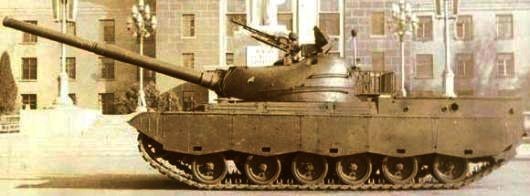The Project 122 remains mythical even until today. In popular media, it is usually wrongly called “WZ-122”, which is in fact a misplaced name. The very genuine WZ-122 is a later medium tank, Type 80, which is almost 10 years after the project 122. However, Type 80 is actually the 5th type of Project 122, and the most mature and reliable one.
To clarify a widely misunderstanding on Chinese ground vehicles, the meaning of the “WZ-” prefix must be explained. “WZ-” is the abbreviation of initials of Chinese Pinyin of «Weapon Equipment» (武wǔ 器 qì装 zhuāng备 bèi), and it is factory designation, not the Army designation. Not all the test prototypes could receive the “WZ-” designation, but only those passed the trials and considered acceptable for mass production. However, these vehicles are still possible to be rejected by the Army, regardless of the permission from government commissions. Hence, there are such tanks like WZ-132, received the “WZ-” prefix but never seen a chance in service of the Chinese army. Meanwhile, vehicles with or without “WZ-” prefix are definitely different ones, but most likely share the same root, like 122 and WZ-122.

To dig out the origin of 122, we cannot omit the occurrence of Sino-Soviet conflict in 1969. The Soviet T-62 captured in Zhenbao/Damansky Island made Chinese authority panicked. The Type 59(Chinese version of T-54A) was immediately considered outdated, and the design requirements were correspondingly aligned to T-62. The first attempt was Type 69(WZ-121) with 100mm smoothbore cannon, and it was even worse than unsuccessful. The gun is weak, and other components are not much better than those on original Type 59. Type 69 is considered acceptable but not enough, then a completely new tank became necessary.

The Baotou Plant 617 took the order, as expected, because there was no other factory capable of designing tanks in China that time. Being a byproduct of the disastrous Chinese cultural revolution, the technical specification of the first 122 design was greatly exaggerated, while the actual capability of Chinese tank industry did not meet the requirements. The first 122 design is usually called as “triple-hydro”, as it features hydraulic transmission, hydropneumatic suspension and hydro-assistive control. The Chinese tank designer creatively installed 2 missile launchers on each side of the turret, firing ATGM.
The “triple-hydro” has a wholly-cast turret with 120mm smoothbore cannon installed in it. The first 120mm smoothbored gun on 122 has a barrel length of 5.75m, which is incredibly close to U-5TS. It has a muzzle velocity of 1610m/s and can penetrate the 120mm RHA placed at 65° from 1000m, with a muzzle pressure of 330MPa. Interestingly, the 122 “triple-hydro” is the very first tank that uses the 120mm smoothbore cannon in the world.

Unsurprisingly, Chinese were unable to put hydropneumatic suspension and hydraulic torque converter into mass production. Again, like Kotin’s compromise on Object 252, here came the second edition of 122, the “triple-mechanical” that replaced those radical parts with mechanical transmission and torsion bar suspension. Apart from these, the 122 “triple-mechanical” retains most of the design of the very first initial “triple-hydro”, including the shape of hull, turret powerpack. However, it has a new 120mm gun with different fume extractor, which looks so visually similar with 115mm U-5TS that this tank is usually confused with some replicated T-62. However, the actual performance of it remains classified even until today, as it is the origin of the Type 89 Self-propelled Anti-tank Gun.

Unfortuanately, the lack of new elements made it ordinary again. It was discarded so soon that the missile launchers were even not installed on it.
By the time when the second design of Project 122 was denied, the Chinese authority had worry about Soviet assault on China from the north. As a result, the reseaches of Project 122 and the facilities of Plant 617 were replicated and transferred to a farther city on the south, Luoyang, which is like the Chinese version of Chelyabinsk, but only smaller and less famous as an industrial city.
The setup of new factory in Luoyang was in April 1970, so the factory was named after this.
Plant 704 restored the mature design of “triple-mechanical” and introduced a mechanical autoloader on the new tank. Comparing with the “triple-mechanical”, the new design changed the shape of the rear part of the turret to suit the autoloader, which is in fact a semi-auto loading assistive mechanism, like a crossover between the ones on French AMX-50 and Soviet IS-7, or neither. It works reliably but not really helpful because it is too slow.
Ironically, this product of Plant 704 never really has any official name, it is usually simply called “the 704 tank” and often confused with ChKZ’s Object 704. In fact, it is the third design of Project 122, and the one reserved the best until today, yet known the least due to the high confidentiality.

The 704 tank is usually regarded as a parallel project or a “fork” of 122, however, it is the very “missing” third edition of project 122. It was discontinued by Plant 704 because of the priority of producing Type 59. Nevertheless, the main branch of project remains in Plant 617.
The upcoming one could be the most impressive one amongst all the editions of built 122 prototypes. The 1224 is a reactivation of the whole project after the end of Chinese cultural revolution. Started by plant 617 in April 1978, the 1224 was actually an attempt to imitate the German Leopard 2, aiming to fight against Soviet T-72.

The Chinese army leader got a chance to visit the factory of Krauss-Maffei in mid 1970s, to have a glimpse of the Leopard 2 that not even enter service yet. They were greatly astonished by the mobility of this German tank. Both German and Chinese wished that Chinese could import or produce Leopard 2 with license, however China could not afford that in late 1970s. The limiting condition is not just the financial budget, but also the facilities and the training level of workers, which are also critical to the industrialization process that Chinese eventually caught up in 1990s.
Undoubtedly, 1224 was never really at the same level of Leopard 2, but it is also undoubtedly unique by that time, as it looks like a mythical hybrid between Soviet tanks and Western tanks.

Although the welded turret is adopted, the 1224 never really has composite armor installed. Unlike conventional cognition on it, the focus and priority of the 1224 tank is never the firepower or protection but the mobility. In fact, it is a brand-new testbed for future weapon platform – new engines, new weapons and new armor. The extra-large engine compartment was designed for MTU MB-8V331 TC 41 engine, a German product. The engine basically suits the technical requirements with the hydraulic torque converter developed by Plant 617 and 2-plate planetary gear, but its only defects are the size and cooling. To over come it, 2 gigantic fans are installed above the engine, which greatly obstacle the backward depression angle of the gun.

The evaluation on 1224 ended with the feedback of “acceptable but not satisfying”. Then the following one, or ones, are more radical again. The 1226 and 1226F2 are no different except the engines. Very few pictures of them are leaked and it is also another highly classified item even until now.
The 1226 uses the 8V165 diesel engine from Plant 636, and the 1226F2 adopted the 12150ZL diesel engine from Plant 616. Both of these 2 engines could deliver a power at 986HP. Both 1226 and 1226F2 use the 5-gear hydraulic automatic gearbox developed by Plant 617. Another “retrospective” design of 1226 and 1226F2 is the return of hydropneumatic suspension. An unknown type of semi-autoloader is used, but the gun barrels are fake and the guns on 1226 and 1226F2 are never tested with real projectiles.This time, the 1226 series are considered satisfying in the trials, but not reliable.

The researches of the whole Project 122 became the foundation of later Chinese tanks, while the final fruition of this project is the WZ-122, AKA Type 80, which is the 5th edition and the most conservative one, named in November 1980. Interestingly, it is never named as “1225”.
The Type 80 no longer uses 120mm smoothbore cannons. The 105mm L7 rifled cannon licensed from Austria became the game changer. In the showdown, the 105mm L7 gun penetrated 2 Type 59 tanks put in a same row with one shell, which greatly shocked the Chinese army leaders once again. Since the recoil distance of L7 is even shorter than 100mm D-10T, it could be easily installed inside the turret of Type 59 yet having better depression angle. The 105mm L7 is first installed on Type 79, and selected to be the next generation of main gun for both Type 80 and the future improvements on Type 59.

To meet the harsh requirements on reliability, the Type 80 does not adopt any autoloader or loading-assisting mechanism and switched back to torsion bar suspension. It absorbs the mature designs from Type 69, 1224 and 1226 series, such as the medium size roadwheels and 12150ZL diesel engine with turbo charger (outputing 730HP).
The Type 80 combines a lot of experience from the Type 69 and Type 79 series and becomes the first step towards Type 96. It is the firstl really modern tank made by China, involving genes from Soviet, Germany and Britain, and the first page of Chinese main battle tanks, as well as the perfect ending of Project 122. The whole project extended through 11 years, involving more than 20 factories and institutes in China, challenging the limits of China’s workers and scientists, and witnessed the extraordinary enthusiasm that the older generation of Chinese tank designers in that restless but glorious era.
Sources:
- Author's photo archive




